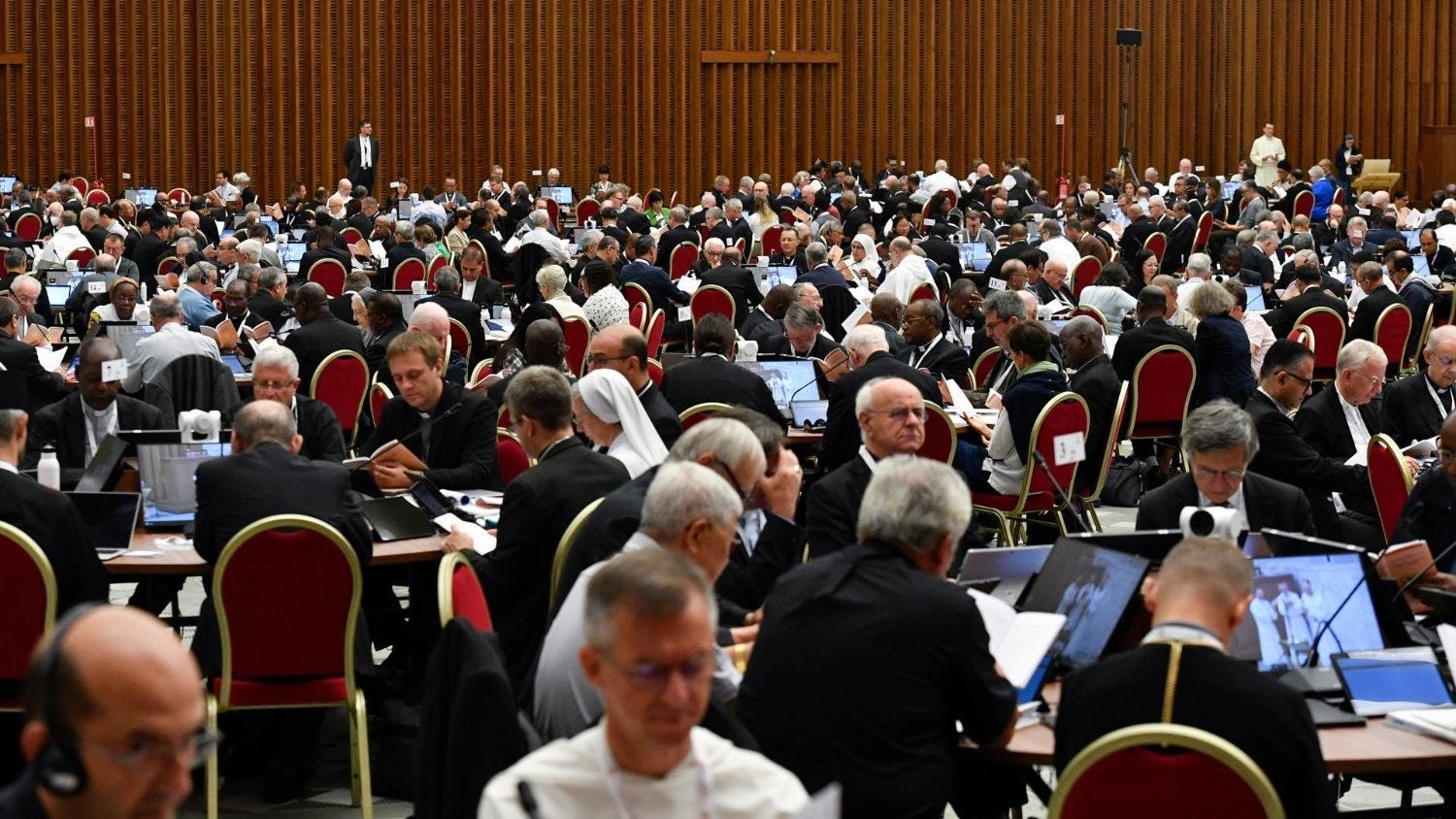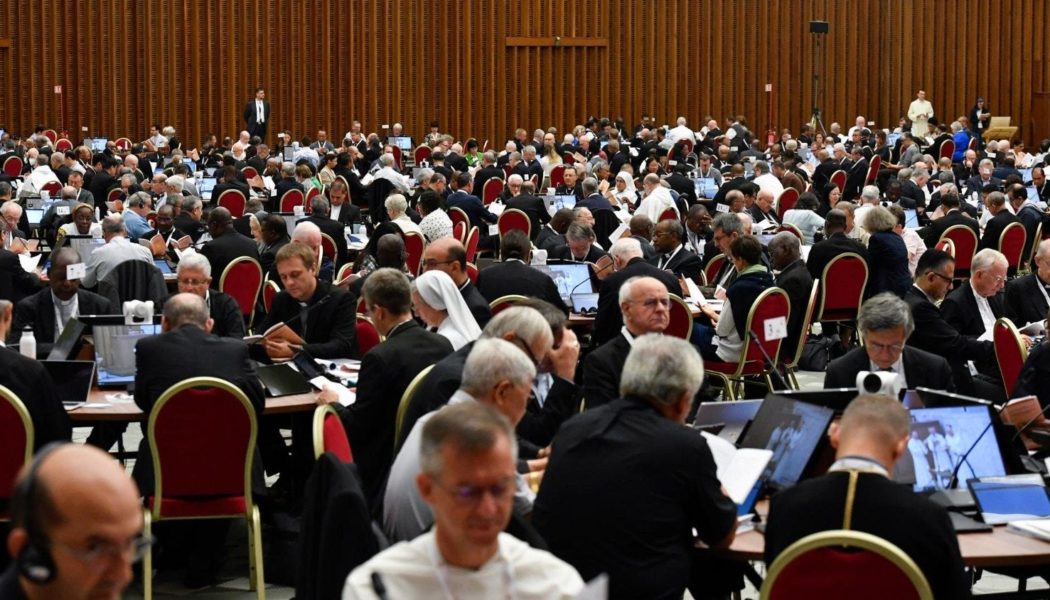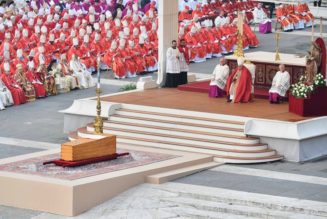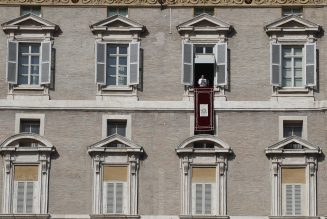
After a month of meetings in Rome, it’s finally now halftime in the synod of bishops’ synod on synodality, with delegates departing Rome to bring the good news about synodality back to their home countries.
As they head out, they will be taking with them the assembly’s interim report document, published Saturday after considerable debate and amendment from the initial draft version produced by the synodal secretariat’s writing committee.
Debate over that text, and the significance of the language used, or not used, in some passages has become the subject of much post-session synodal debate.
How significant was the deletion of the term “LGBT” from the text? How broad is the support for considering women’s ordination to the diaconate? Does the scrapping of a call for a permanent, elected synodal body argue for or against Pope Francis’ vision for a synodal Church?
All these questions, and others, have been the focus of post-session spin and commentary from the Vatican commentariat, and from synod delegates themselves.
And, had this final version of the text represented the synod’s last word, there would be, perhaps, real urgency to these discussions as the Church waited for the pope’s post-synodal apostolic exhortation.
But the true importance of the synodal halftime report may lie less in what it concluded, and more in the debate it generates, during the year-long break before the October 2024 session of synodality synod.
The interim report, rather than taken as a look at where the synod stands on many topics, might be better seen as an indication of where its different constituencies want the synod to get — with the text a useful tool for hyping or tempering expectations, and for moving the ecclesiological Overton window ahead of next year’s session.
—
Scanning the top line of reactions from synodal participants and commentators, the initial consensus would seem to be that the assembly had pushed back on the more radical proposals from some quarters.
Fr. James Martin, SJ, a papal invitee to the synod, expressed his disappointment shortly after the document came out, saying that he “would suspect that most LGBTQ Catholics will be disappointed that they are not even mentioned in the final synthesis.”
“The document, as it turns out, does not reflect the fact that the topic of LGBTQ people came up repeatedly in both many table discussions and the plenary sessions, and provoked widely diverging views.”
But Martin’s views can be both correct, and at the same time intended to shape expectations. Self-identified LGBTQ Catholics may well be disappointed that homosexuality is not directly addressed in the way Martin says, and it may be true to say that the final interim text does not reflect the fact that the topic was raised repeatedly with “widely diverging views.”
To say that views on s subject are “widely diverging” is not the same as saying equal numbers of people held them.
The issue might have been frequently raised by a small number of attendees, as synod sources have indicated to The Pillar, and examination of the texts of table reports from the first round of the synodal session would seem to bear that out.
From that perspective, the synodal document not making explicit reference to “LGBTQ Catholics” might actually reflect well the feelings of the synodal majority.
Similarly, advocates for the ordination of women were certainly present at the synod, and made loudly their calls for the Church to revisit its sacramental theology.
But the wording of the final text was extremely cautious, and in reality went no further than the previous synod on the Amazon, and called only for “more study.”
In fact, most of the controversial topics at the current synod have featured prominently in previous synodal sessions and failed to make the kind of progressive strides predicted for them — at least for the moment.
Some of the more dramatic structural reforms for the Church floated in the interim report were also previously failed proposals for papal legislation: The interim report flagged as “necessary” the need to “study the doctrinal and juridical nature of the episcopal conferences, recognizing the possibility of collegial action also with respect to doctrinal issues that emerge in the local context.”
This call for doctrinal subsidiarity through episcopal conference has been long championed by the Church in Germany, but the same proposal was inserted in an early draft of Praedicate evangelium, the pope’s constitution for the Roman curia, before being removed prior to its promulgation last year.
In a sense, the current synodal session, defined as it has been under the amorphous heading of “synodality” seems to have become a kind of conversation about everything and nothing in particular about the life of the Church, with some participants using it as chance to throw a spaghetti bowl of agenda items at the walls of the Paul VI Hall and see what sticks.
While there may be considerable overlap between the supporters of those various causes, none of them appears to enjoy broad support among the assembly at large.
Instead, the drafting and amending of the synodal text seems to suggest that these minority voices do have the benefit of support from the drafting committee, ensuring that their preferred issues are referenced obliquely, in order to command a necessary majority to pass a vote.
In that light, expectations that the synod will go on to propose seriously, or for Pope Francis actually to adopt, calls for women’s ordination or the overturning of Church teaching on human sexuality would appear to be overblown — as they proved to be in previous synodal sessions.
But, for those eyeing the synod as a vehicle for progressive reform, but doctrinally and structurally, achieving a single tangible output may be less important that framing the conversation for the global Church for years to come.
One particularly insightful summation of this vision of a “synodal Church” came from Cardinal Robert McElroy of San Diego, who seemed to propose that teaching is to be understood as shaped by pastoral practice, rather than the other way around.
“It is not that doctrine comes first,” the cardinal said in a recent interview. “Doctrine stands in service to the pastoral mission of the Church.”
Such a statement would probably have struggled to gain a necessary majority to feature in the synodal text — on the contrary, the assembly voted to insert several references to the Magisterium into the interim report which were not there in the draft text.
But the bishops of Germany have demonstrated that the teachings of the Magisterium and the absence of an explicit papal placet are not necessarily bars to pushing ahead with otherwise controversial pastoras plans, such as the offering of ritual blessings for same-sex couples in churches.
The response of bishops when challenged on such issues has been, in effect, to say that there is an ongoing conversation about such things in the Church, and that the fact of the conversation creates a pastoral freedom to act even contrary to doctrine.
—
Perhaps the most interesting facet of the synodal sessions now concluded is the way in which it stacks up against Francis’ own stated visions for a global synod on synodality.
In 2019, Pope Francis wrote that true synodality and what it can bring to the Church isn’t meant to be about “structural, organizational or functional change.”
“One of the first and greatest temptations in the Church [is] to believe that the solutions to current and future problems would come only from purely structural or bureaucratic reforms,” Francis wrote to German Catholics, calling the impulse to focus on power and governance “a sort of new Pelagianism, which leads us to place trust in administrative structures, in perfect organizations.”
Instead, Francis has repeatedly said the syondal process should be about the urgency to evangelize, and for the Church to bring itself closer to the poor, marginalized and victimized. The presence of lay participants as voting members of a meeting of the synod of the synod of bishops has been highlighted as a particular innovation geared towards this aim.
But which peripheries the synod as focused on remains a controversial point, as does the text’s priorities for better incorporating the “margins” of society into the heart of the Church’s life and institutions.
Many synod watchers, and more than a few participants have noted that a considerable amount of time and space was given to discussing issues of sex, gender, and Church governance primarily of concern in affluent European and North American countries.
Earlier this week, one synod delegate told a press conference that the Church must have a “preferential option for the laity” in its governance and ministry, presumably meant as a kind of witty play on the preferential option for the poor.
But for at least some synodal participants, it has betrayed a focus on structures, power, and governance — the kind of institutional and organizational mindset the pope cautioned against — at the expense of the actually poor and truly victimized in parts of the world where the faithful are under violent attack.
The extent to which the synodal conversations remain focused on what many might consider to be “first world ecclesiastical problems” could yet prove to be the real barometer or its success or failure against Pope Francis’ original vision.
Comments 20
Services Marketplace – Listings, Bookings & Reviews








